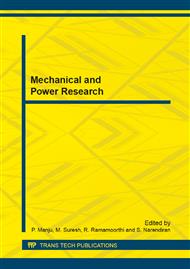[1]
A Iwata, C Chiang, G Pei, M Gerla, T Chen, Scalable routing strategies for ad hoc wireless networks. IEEE J Select Areas Commun. 17(8), 1369–1379 (1999).
DOI: 10.1109/49.779920
Google Scholar
[2]
David B. Johnson. Routing in ad hoc networks of mobile hosts. InProc. Qfthe IEEE Workshop on Mobile Computing System and Applications, pages 158- 194, December (1994).
DOI: 10.1109/wmcsa.1994.33
Google Scholar
[3]
Charles E. Perkins and PravinBhagwat, Highly dynamic Destination-Sequenced Distance-Vector routing (DSDV) for Mobile computers. In Proc. ACM SIGCOlwMCoqference (SIGCOMM'94), pages 233-244, August (1993).
DOI: 10.1145/190809.190336
Google Scholar
[4]
Charles Perkins, Elizabeth Royer, and SamirR. Das. Ad hoc on demand Distance Vector (AODV) routing. (Internet draft). October (1998).
DOI: 10.17487/rfc3561
Google Scholar
[5]
J Sucec, I Marsic, Clustering overhead for hierarchical routing in mobile ad hoc networks. in IEEE Infocom, (2002).
DOI: 10.1109/infcom.2002.1019423
Google Scholar
[6]
M Jiang, J Li, YC Tay, CBRP-IETF MANET Draft. National University of Singapore, August (1999).
Google Scholar
[7]
ZChunhua, T Cheng, A K-Hop passive cluster based routing protocol for MANET. in 5th International Conference on Wireless Communications, Networking and Mobile Computing, WiCom'09, (2009).
DOI: 10.1109/wicom.2009.5301764
Google Scholar
[8]
YB Ko, NH Vaidya, Location-aided routing (LAR) in mobile ad hoc networks. in Proceedings of the 4th Annual ACM/IEEE International Conference on Mobile Computing and Networking, 25-30 October 1998,. p.66–75.
DOI: 10.1145/288235.288252
Google Scholar
[9]
M Mauve, J Widmer, H Hartenstein, A survey on position-based routing in mobile ad hoc networks. IEEE Netw Mag. 15, 30–39 (2001).
DOI: 10.1109/65.967595
Google Scholar
[10]
GSTomar, RS Tomar, Position based routing for mobile ad hoc networks. In Second UKSIM European Symposium on Computer Modeling and Simulation, p.555–560 (2008).
DOI: 10.1109/ems.2008.101
Google Scholar
[11]
SCapkun, M Hamdi, JP Hubaux, GPS free positioning in mobile ad hoc networks. in Cluster Comput J. 5(2), 157–167 (2002).
Google Scholar
[12]
A Caruso, S Chessa, S De, R Urpi, GPS free coordinate assignment and routing in wireless sensor networks. in Proceedings of the IEEE INFOCOM, 2005, 24th Annual Joint Conference of the IEEE Computer and Communications Societies, p.150–160 (2005).
DOI: 10.1109/infcom.2005.1497887
Google Scholar
[13]
HAkcan, V Kriakov, N Bronnimann, GPS-Free node localization in mobile sensor networks. in Proceedings of the 5th ACM International Workshop on Data Engineering for Wireless and Mobile Access, p.35–42 (2006).
DOI: 10.1145/1140104.1140113
Google Scholar
[14]
RIyenger, B Sikdar, Scalable and distributed GPS free positioning for sensor networks. in Proceedings of IEEE Conference on Communication ICC. 2003, vol. 1, p.338–342.
DOI: 10.1109/icc.2003.1204195
Google Scholar
[15]
OH Kwon, HJ Song, Counting-Based Distance Estimations and Localizations inWireless Sensor Networks. Springer., 2006: 3983/2006, p.306–315.
DOI: 10.1007/11751632_33
Google Scholar
[16]
HC Chu, RH Jan, A GPS-less, outdoor, self positioning method for wireless sensor networks. Ad HocNetw (Elsevier Sci). 5(5), 547–555 (2007). doi: 10. 1016/j. adhoc. 2006. 03. 004.
DOI: 10.1016/j.adhoc.2006.03.004
Google Scholar
[17]
N Bulusu, J Heidemann, D Estrin, GPS-less low cost outdoor localization for very small devices. in IEEE Personal Communications Magazine, Special Issue on Smart Spaces and Environments, October (2000).
DOI: 10.1109/98.878533
Google Scholar
[18]
D Deb, SB Roy, N Chaki, LACBER: a new location aided routing protocol for GPS scarce MANET. Int J Wireless Mobile Netw (IJWMN), 1(1), 22–36 (2009).
Google Scholar
[19]
SenthilVelmuruganMangai and AngamuthuTamilarasi, ILCRP: A new approach to geographic routing for location aided cluster based MANETs. EURASIP Journal on Wireless Communications and Networking (2011).
DOI: 10.1186/1687-1499-2011-18
Google Scholar


